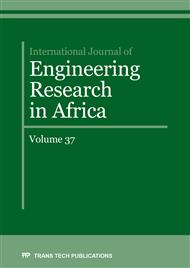[1]
J. Kazmane, A. Ennadi, A. Chafi, I. Tajri, Design of a strategy supply chain aligned with the strategy of the company. International Journal of Engineering & Technology, 2017 pp.368-377.
DOI: 10.21817/ijet/2017/v9i1/170902315
Google Scholar
[2]
B.Z. Hull, Are supply (driven) chains forgetting? The International Journal of Logistics Management, 2005 p.218–36.
Google Scholar
[3]
R. Mason-Jones, B. Naylor, D.R. Towill, Engineering the leagile supply chain. International Journal of Agile Management Systems, 2000 p.54–61.
DOI: 10.1108/14654650010312606
Google Scholar
[4]
H. Carvalho, & V. Cruz-Machado, Integrating lean, agile, resilience and green paradigms in supply chain management (LARG_SCM), Third International Conference on Management Science and Engineering Management. (2011).
DOI: 10.5772/14592
Google Scholar
[5]
C.W. Craighead, J. Blackhurst, M.J. Rungtusanatham, R. B.Handfield, the Severity of Supply Chain Disruptions: Design Characteristics and Mitigation Capabilities. Decision Sciences, 2007 pp.131-156.
DOI: 10.1111/j.1540-5915.2007.00151.x
Google Scholar
[6]
C. S. Tang, Robust strategies for mitigating supply chain disruptions. International Journalof Logistics Research and Applications: A Leading Journal of Supply Chain Management,2006 p.33.
DOI: 10.1080/13675560500405584
Google Scholar
[7]
Q. Zhu, J. Sarkis, & K. Lai, Confirmation of a measurement model for green supply chain management practices implementation. International Journal of Production Economics, 2008 pp.261-273.
DOI: 10.1016/j.ijpe.2006.11.029
Google Scholar
[8]
M. C. Cooper, L. M. Ellram, J. T. Gardner A. M Hanks. Meshing Multiple Alliances. Journal of Business Logistics, 1997 pp.67-89.
Google Scholar
[9]
D. Everton, E. Sergio, P. Edson, W. Heliore, lean supply chain management: Practices and Performance Mesures, Industrial and systems Engineering Research conference, (2012).
Google Scholar
[10]
B.J. Naylor, M. M. Naim, D. Berry, Leagility: Integrating the lean and agile manufacturing paradigms in the total supply chain. International Journal of Production Economics, 1999 pp.107-118.
DOI: 10.1016/s0925-5273(98)00223-0
Google Scholar
[11]
A. Agarwal, R. Shankar, M. K.Tiwari, Modeling the metrics of lean, agile and leagile supply chain: An ANP-based approach. European Journal of Operational Research, 2006 pp.211-225.
DOI: 10.1016/j.ejor.2004.12.005
Google Scholar
[12]
M. Christopher, D. R. Towill, Supply chain migration from lean and functional to agile and customized. Supply Chain Management: An International Journal, 2000 pp.206-213.
DOI: 10.1108/13598540010347334
Google Scholar
[13]
Y. Kainuma, N. Tawara, A multiple attribute utility theory approach to lean and green supply chain management. International Journal of Production Economics, 2006 .pp.99-108.
DOI: 10.1016/j.ijpe.2005.05.010
Google Scholar
[14]
V. Hariram, R. Harishkumar Improving Supply Chain Performance through Lean and Green – A study at Volvo Group India and Sweden, 2012. Pp 89-102.
Google Scholar
[15]
F.R. Jacobs, R.B. Chase, Operations and supply management. twelve ed., McGraw-Hill, United States, (2009).
Google Scholar


